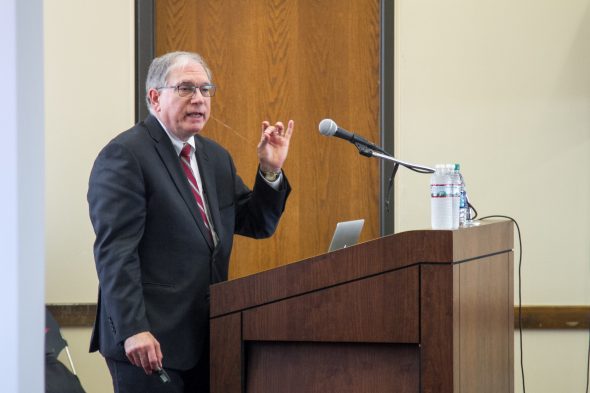NIH deputy director addresses ways to combat opioid crisis

Lawrence Tabak, principal deputy director of the National Institutes for Health, speaks in Student Center East Oct. 3. (Photo: Fan Wang)
National Institutes of Health principal deputy director Dr. Lawrence Tabak spoke to an audience of faculty, staff and students at Student Center East Oct. 3 about how the nation’s largest public research funding agency is helping to combat the opioid epidemic. In April, the NIH launched the HEAL (Helping to End Addiction Long-term) Initiative, to address the public health crisis of opioid misuse and addiction in the United States.
The NIH HEAL Initiative builds on extensive, well-established NIH research, including knowledge of the complex neurological pathways involved in pain and addiction, to identify and test treatment models and develop integrated behavioral interventions and medication-based treatment options for people with opioid use disorder.
The HEAL Initiative will not only fund translational research into opioid misuse and treatments for addiction, but it also will develop multiple clinical trials networks to quickly test the efficacy of new treatments and therapies to speed their delivery to the public.
“About 2 million Americans are affected by the opioid crisis,” Tabak told the audience. “And most of those addicted to opioids got there because they were prescribed the drugs to treat pain.”
Tabak said that about 25 million Americans report pain each day.
“But only some people who report an incidence of acute pain go on to develop chronic, ongoing pain,” he said. Understanding why some people’s acute pain becomes long term is one of the research areas the HEAL Initiative will focus on.
Identifying better treatments for pain is another area of focus.
“We know more about the neurobiology of pain today than we ever have, but we haven’t done a great job of translating that knowledge into non-addictive interventions for the treatment of pain,” Tabak said. A vaccine against pain is another research project the HEAL Initiative will fund.
Uncovering biomarkers of pain so that it can be studied and measured more objectively would help both in developing new treatments and gaining a better understanding of how and why people experience pain differently, he explained. HEAL Initiative researchers will also look for new targets for novel drugs to block pain. Already, NIH-funded scientists have zeroed in on certain cell membrane ion channels that seem to mediate pain. Drugs that interact with these channels may help block pain signals, providing a viable non-opioid alternative to treating pain.
Tabak mentioned a collaborative project between the National Institute on Drug Abuse and the National Institute of Allergy and Infectious Disease — both part of the NIH — involving the use of antibodies that bind to opioids, preventing them from crossing the blood-brain barrier and blocking their euphoric effects. The antibodies “could help dampen the high felt by users and could help prevent those in recovery from relapsing, which we know is a common among those trying to get off opioids,” Tabak said.
Preventing deaths from opioid overdose is an area where NIH-funded research has already yielded benefits on the ground. A new nasal spray based on NIH-funded research that delivers the drug Narcan — an opioid antagonist used for the complete or partial reversal of opioid overdose, including respiratory depression — puts the ability to save a life into the hands of almost anyone.
“Most people who aren’t health care providers wouldn’t necessarily be comfortable administering Narcan via injection, but anybody can use a nasal spray,” he said.
“About 80 percent of people with opioid use disorder don’t get effective treatments.”
Many of those with opioid use disorder are in jail, where treatment, if offered, may be of varying quality from facility to facility. When these people get released, relapse is a major risk.
“The NIH is also reaching out to the justice system to find ways we can work together to address this crisis,” he said.
“We need more alternatives to treat pain, and better therapies for treating opioid addiction and preventing relapse,” Tabak concluded. “Gaining a better understanding of the neurobiological processes involved in pain and addiction and basic research projects supported by the HEAL Initiative will give us much-needed additional options to tackle this national health crisis.”
